September, 2014
by Barbara Griffin
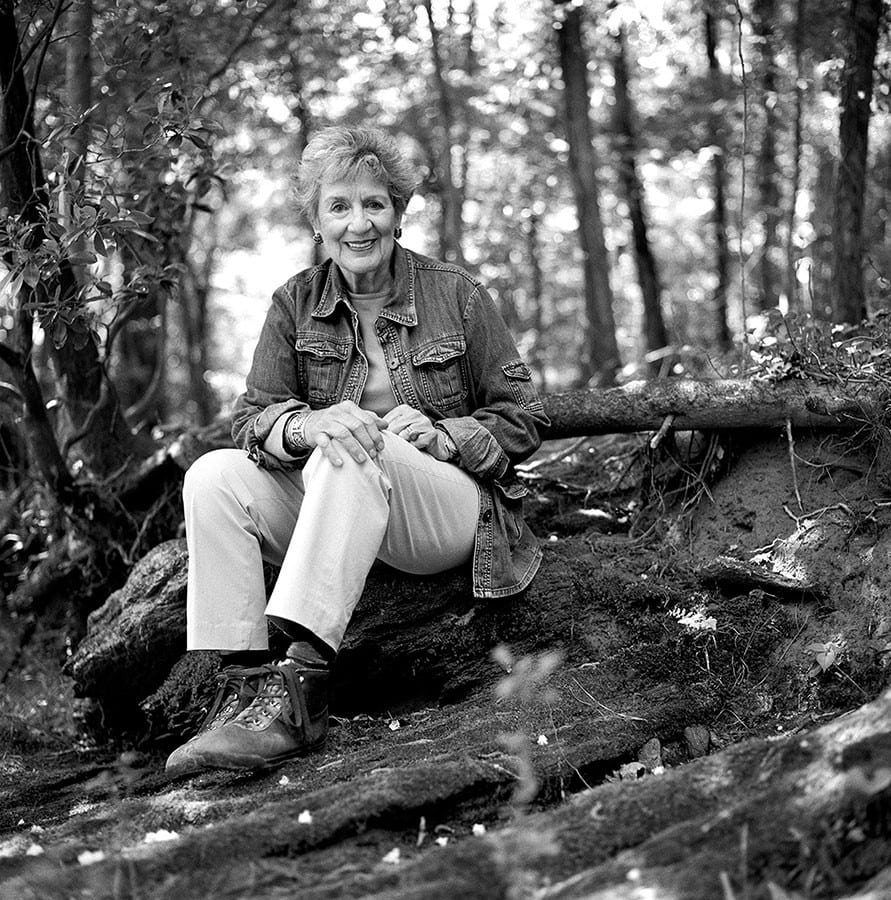
Intro
This past July, Barbara Griffin had the wonderful opportunity to sit down and talk for a very, very long time (around five hours) with the remarkable Lucinda Bunnen, noted Atlanta photographer, arts advocate, and philanthropist, and her assistant Matthew Terrell. One of Lucinda’s four photographic projects of the moment involves working with old found slides she’d taken in the 1960s and re-envisioning them by “watering” them, or setting them out in the rain, then sometimes pulling them apart, other times manipulating them, to see the new/old images emerge. They also touched on the other three projects she currently has underway as well as stories of her life as a constantly re-emerging artist at the age of 85.The conversation was a long and beautifully winding road; here are some of the highlights.
Barbara Griffin: So…my first question for you, Lucinda, is this…a life lived with photography is a passionate life, almost a calling, that once answered must be followed. What brought you to photography and how has your love of image-making and appreciation evolved over time?
Lucinda Bunnen: I met a man named Tullio Petrucci at the Arts Festival in Piedmont Park. He was the exhibition director and I was the membership director. We started walking around the park, saying this is what we were going to do and he was talking about art. He was a teacher at the Atlanta College of Art in basic drawing. I knew nothing about art and I felt as if he was opening doors and windows to me and I was fascinated. Then he started a company called And. And Media Studio. And meant, we do this and this and this and this and this. And they did. So anyway, they were making films and I went with my camera and started photographing everything that was going on. Fascinated by the whole thing. Then I would come back with my prints and Tullio would look at them in his chair and he would put a pile on one side of him and a pile on the other. And I didn’t know which was the “good” pile and which was the “bad” pile. Just didn’t have a clue.
Anyway, he believed in me and he got a job working at the High Museum doing a show called The City. I became the photographer and I did a 5-screen slide show, which meant 10 trays of slides went in and out…it was an audiovisual show and I was in charge of keeping the audio and the visual together, which didn’t happen very often. I was having a blast with him and his company and all the people that worked there.
Then, my 40th birthday came up and I said “No party here, I want to go somewhere with my whole family…you make the plans and we’ll meet you there.” So we went to Peru. I bought a Super 8 camera and made my first film in Peru. I brought it back and I edited it here with my little editing machine. I took it and showed it to them and they went berzerk. They said “You really have something, you need to go to photography school.” So I went and took a class in photography and, I missed the first class because it was our week at the beach. There were 5 nuns walking around in their black habits on the beach and I went chasing after them (with his camera, because I didn’t even have a camera) and my husband went chasing after me saying I couldn’t do that. I said it’s a public beach and I can do whatever I want. And it sort of gave me the power to think I could do what I want and I didn’t always have to listen to him. So, I took my first roll of film.
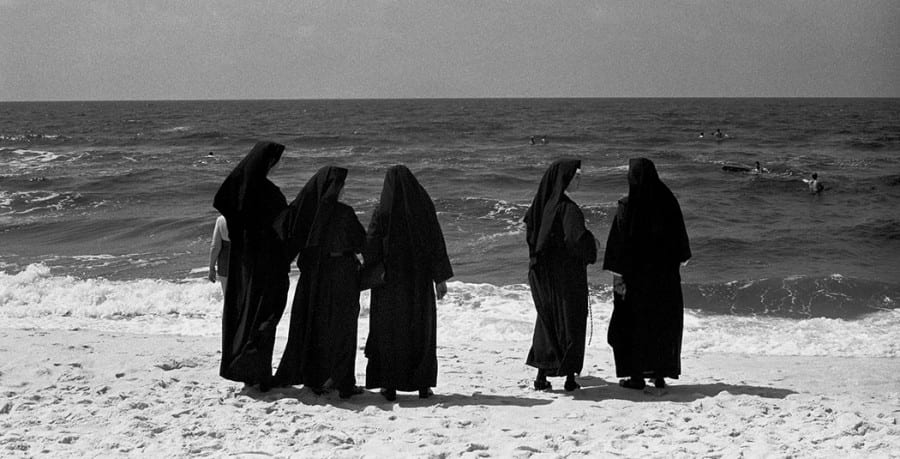
Two friends of mine invited me to go to this class with them, and they had a dark room because one of them had a son who was a photographer. They developed my first roll of film and they were like “oh my god, oh my god”. I took my nuns to class and Tullio went berzerk. Every assignment, I thought I had done all the wrong things because I did things that nobody else was doing. We had an assignment to go shoot windows. I was on 14th Street with all the hippies going by watching the girls, smoking pot, and it was all a reflection in the window, so I learned how to print because that was really difficult to print. And he just thought that was the greatest assignment. Everyone else had just done geraniums in the window or whatever. So I was beginning to get confidence in myself. Every assignment I did was different from what everyone else was doing. And then photography critic A. D. Coleman came down and he said it was like I was shot out of a cannon. So anyway, it was just all very exciting. So you can imagine I became passionate about photography.BG: Has it been a life-long passion? LB: It has been since…that was 1970. I went skiing with a friend of mine and the snow was rained away…oh, my teacher at the Atlanta College of Art said I was shooting too fast…I should get a bigger camera, 4×5. So I got a secondhand 4×5 camera and they said I could stop anytime I wanted. He was so impressed with what I was stopping to shoot. He couldn’t imagine what I was seeing. He had come here to open Saks…which is still Saks Fifth Avenue. So he gave me a show in Saks Fifth Avenue. And I got a write-up in the newspaper with a picture and I had 99 pieces pinned up in this little cubicle that he gave me for my show. I was the curator, of course I put in everything I’d ever shot probably…because it was all great (laughs). Anyway, Gudmund Vigtel came to see the show, because it’d been written up in the newspaper. And he invited me to be in the Georgia Artists exhibit. I hadn’t been shooting for more than 6 months at that point. And then Richard Hill saw the Georgia Artists exhibit and invited me to have a show in his gallery on Pharr Road in Buckhead. It was the first gallery to show just photography. Anyway, he just made a book with some of my pictures in it.BG: Did you feel like you were in the midst of a whirlwind? LB: Oh, yes! Then Richard’s mother said she was going to Russia with her husband and why didn’t he send some pictures with her to exchange for some Russian images. So she had to go to Washington to take these images to the State Department to look at before they could send them. He had given her 50 images to take. Most of them were from professors from colleges around the South… and me! They accepted ten pictures and one of them was mine. Then when they presented it in Russia, they were like “What? She’s a little old housekeeper and she can make photographs?”(BG and LB laugh)
LB: Anyway, it was really very funny when they came back and then I had something on my resume. I had a photograph in the Pushkin Museum! In my first year of working.
BG: It sounds like your vision was already ahead of your knowledge of the technology of shooting.
LB: I had 3 kids at that point and I was busy doing baby stuff.
BG: But not knowing the technology has never slowed you down.
LB: Never. I met photographer and critic Virginia Warren Smith and I had a camera that was completely manual. I then got a more up-dated camera and she said I did much better with the manual. Because I knew the very basic things. I still don’t know much about anything. I was taking a course from Minor White and the gardener looked at my camera and said “What have you got there? Do you do this?” And I said, “What’s that?” He knew more about the camera than I did.
BG: Is it your instincts? Do you just go with your instincts?
LB: Where there is a will there’s a way. I’m going to get it one way or the other. I come back with these images and my printer says “OK, you need to get on a tripod and you need to do this and you need to do this”…so I do that. Everybody has helped me.
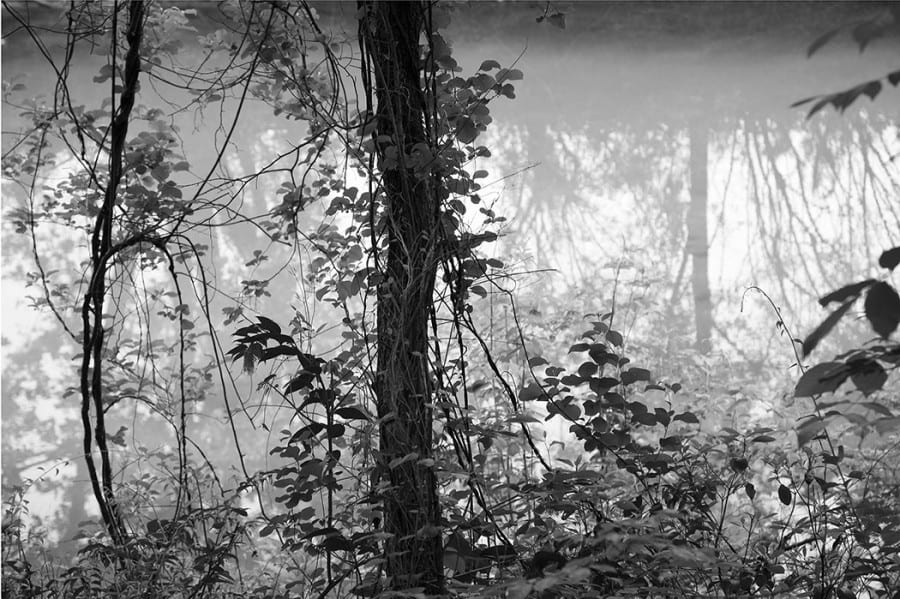
LB: I love nature as you can see. I live in the middle of it. I was up in Tiger, GA, and ran into Bob Hatcher who I knew from previous times, and he said let me take you and show you my new Poplar trees. And I said “Oh, great because I’m doing a show on trees in LaGrange, Georgia, and sure, I’d love to go with you”. So anyway, we went and we drove around the lake and he showed me his Poplar trees. I don’t know what attracted me to the lake but I said “Can I come back sometime and photograph in your pond?” It was a pond, not a lake. So he said “Sure.” It wasn’t far from where my daughter has a house at Lake Rabun. So I was going up there anyway. And I went back about a thousand times over a 2- or 3-year period. It was in the wintertime, because I liked the sticks. The abstractness. I’ve always been attracted to abstraction and they got more and more abstract as I went along. Bob Hatcher’s wife is a painter and she likes to go down there and paint in the summertime…the flowers. And she could not for the life of me understand what I was doing there in the ice, I mean literally in the ice…my fingers were freezing. But where there was a will there was a way and I did it regardless of it being hard to do.
BG: It was almost a precursor to what you’re doing now in some ways.
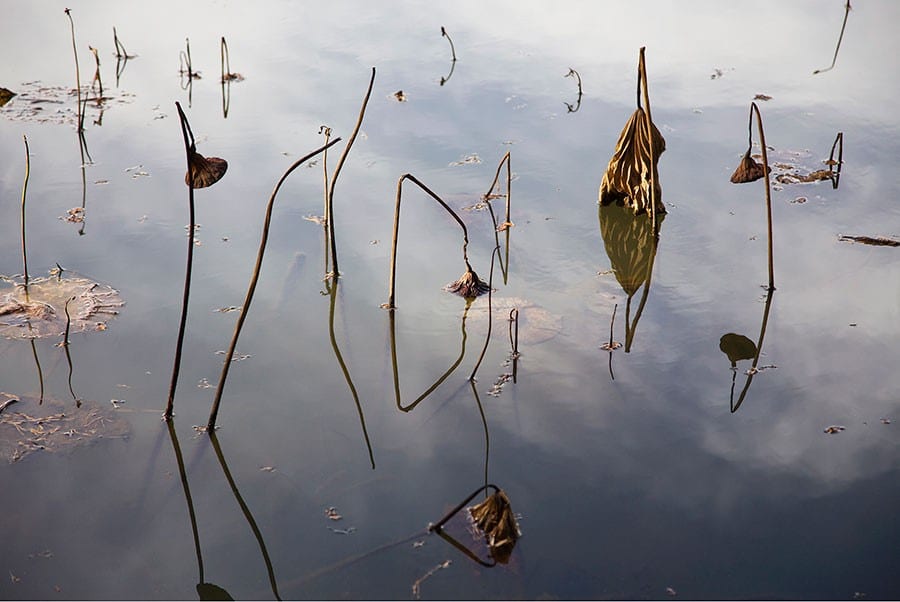
BG: I would be too!
LB: And so exited about that. I really liked the colors, they were very earthy as opposed to Kodacolor or Ektacolor. So of course now I’m working with chromes, Kodacolor and Ektachrome, and doing the same thing. It’s heat and water …
Matt Terrell: And time.
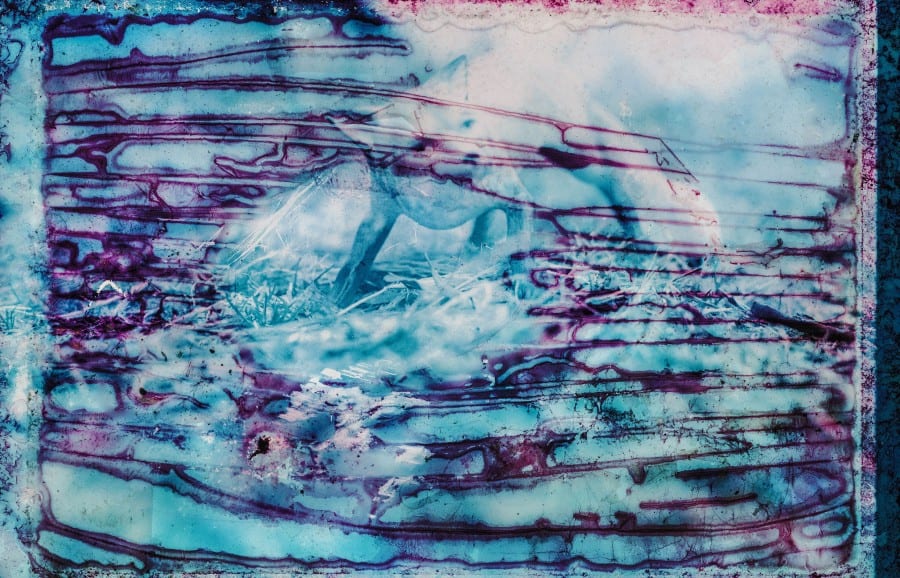
BG: They’re beautiful. Photography as a medium continues to emerge, shift and change…how has that impacted your work over time? Whether it’s the transition from film to digital, or even visual trends?
LB: I loved double exposing and now you can double expose by finding reflections but I really got dragged into the digital age…you gotta do it. And there were so many things I couldn’t do anymore. I double exposed a lot of things by accident because I would have a roll of film in my pocket and I hadn’t rolled the leader all the way in and I would quickly take it and put in the camera and get some of the most amazing things. I was in China photographing stones on the walkway that were big stones, and a brick wall. I wanted just a plain brick wall. A man came along and said “Don’t you want me to stand in your picture?” And I said, “No, thank you” and I had to really push him away because he was sure that I needed somebody in that picture. That was in Beijing. And then I went to Shanghai and went to this museum where things are from 300 B.C., these artifacts that were so amazing. So I was taking pictures of them and next thing I knew I had double exposed a roll of film and I had a 300 B.C. man standing in front of that wall.
BG: So that guy was right, you needed someone in that picture…it just wasn’t him.
LB: Laughs…he wasn’t old enough.
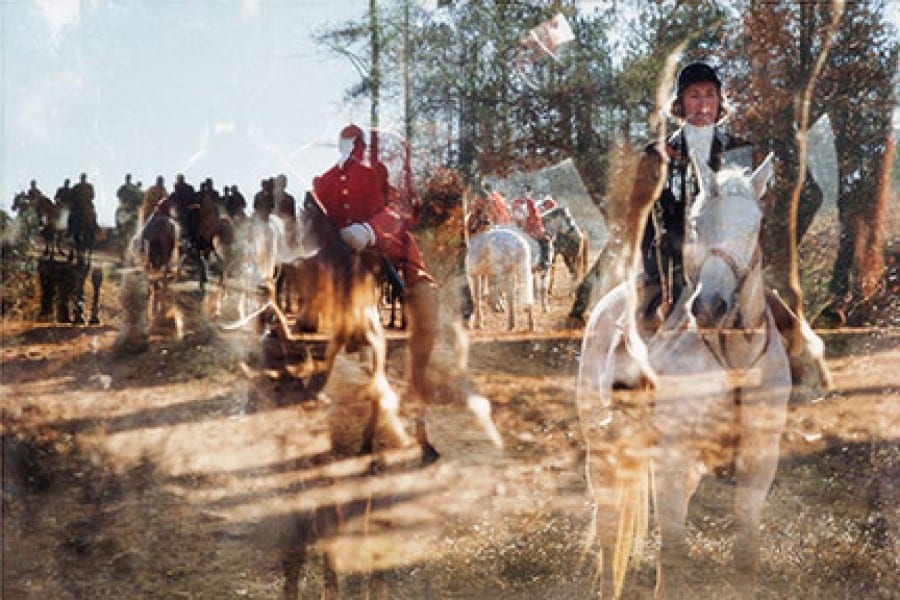
LB: I was doing a lot of fox hunting and riding and my friend Tullio Petrucci said “I want to go with you on one of the hunts and we’ll photograph and film.” We did and he made a film of the hunt. And we were going to double expose. So he was very careful to mark the beginning of the frame so every frame would come out perfectly. He also was very knowledgeable about art and he said we’d need to do just trees and then we’ll do horses and then we’ll come and do horses closer together so there are a lot of triple exposures. There are some of me in them so he was taking pictures and I was taking pictures. That was a huge learning experience for me. I got into the digital period and I was looking at cameras not too long ago and I saw that there was one that you could double expose but I didn’t like the camera and I took it back even though it would have enabled me to double expose. Now I don’t care because I HAVE all these double exposures and I HAVE all these pictures that nature is taking care of.
BG: Do you still shoot film?
LB: No. I don’t.
BG: Well, you have so much to work with.
LB: I have some pictures of the boxer Muhammad Ali…John (Dean Imaging) won’t even print them because they’re out of focus. My son desperately wants those pictures because they are of Muhammad Ali before he was Muhammad Ali…He was…
BG: Cassius Clay
LB: Written on the box, Cassius Clay!
BG: Are they all out of focus?
LB: Well, I can’t find all of them in the first place…they’re somewhere.
M: They’re around here somewhere.
BG: They’ll appear.
M: That’s how it works around here.
BG: Recently during our delightful lunch with photographer Burk Uzzle, Art Force’s Janet Kagan, and SXSE Publisher Nancy McCrary, we were discussing emerging photographers and the overall consensus between us all is that you, even though an established photographer, are consistently emerging. Your work is never static and you continue to challenge yourself. What drives your continuous emergence?
LB: It just happens. You know I have nothing to do with it. Really. I think I’m very open to change, willing to go with the flow. And it’s what keeps me going because I’m so excited every day about what’s happening. I’m not so excited about what I can’t find. It doesn’t matter because there is plenty.
BG: This issue of SXSE is focused on emerging photographers. You are someone who continues to emerge to challenge yourself, to reinvent, innovate and push your work in new directions. Talk a bit about that. You are so willing to try the unknown and let something amazing happen.
LB: It’s what I do. It just unfolds. I don’t go looking for specific things, I think I just find things. I’m open. Some people are out looking for specific things. I’ve done a bunch of road trips with photographer Judy Lampert and she is looking for indigenous houses in the South. Every time we stop, she’s taking pictures of houses and I go around in the back and I always spot something…that big tree stump in the entrance, which you may not have seen yet as it’s an obstacle course. Anyway that was something I found…I wasn’t looking for that, it came to me. And fortunately I was able to get it into my camera. I think I’m just lucky. I think things drop out of the sky. If I’m looking for something I look for something for days and days and all of a sudden it falls out of the sky and onto my desk. I think that’s what happens and maybe if you’re open enough to see it, to feel it, to hear it, to know that’s what you’re looking for, you get it.
BG: It’s not something you can force.
LB: No. Forcing doesn’t work.
BG: Looking at your body of work to date do you see common threads leading from one project to the next or are they independent of each other?
LB: Right at this given moment I happen to be working on 4 separate bodies of work.
BG: Amazing.
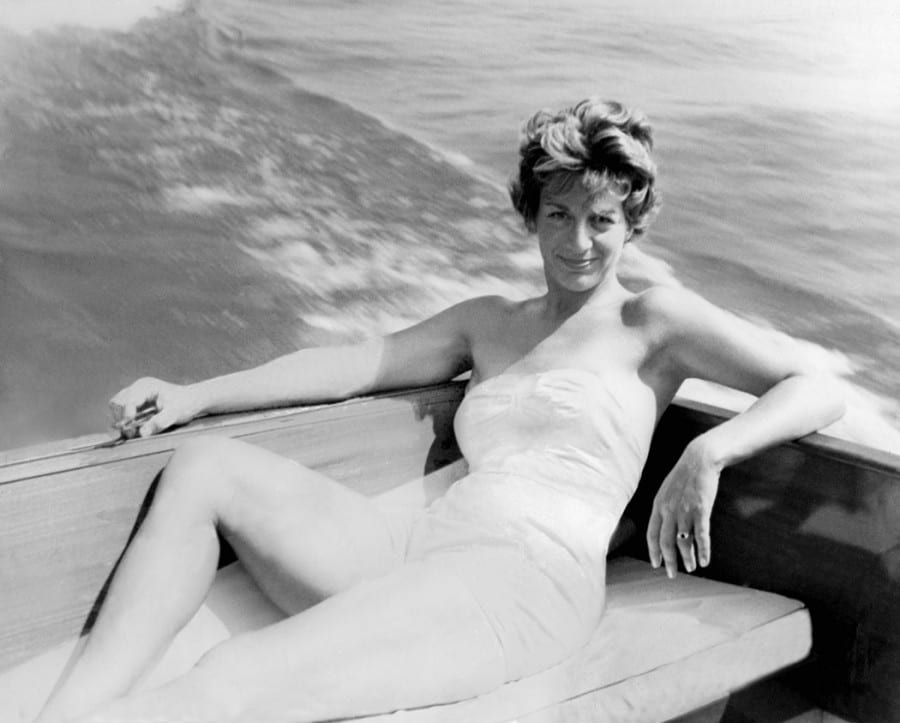
M: A Collection of Collections.
LB: A Collection of Collections and they’re fabulous. I’ve kept going since the ice storm. I was sitting at breakfast the other day and thought that was a collection.
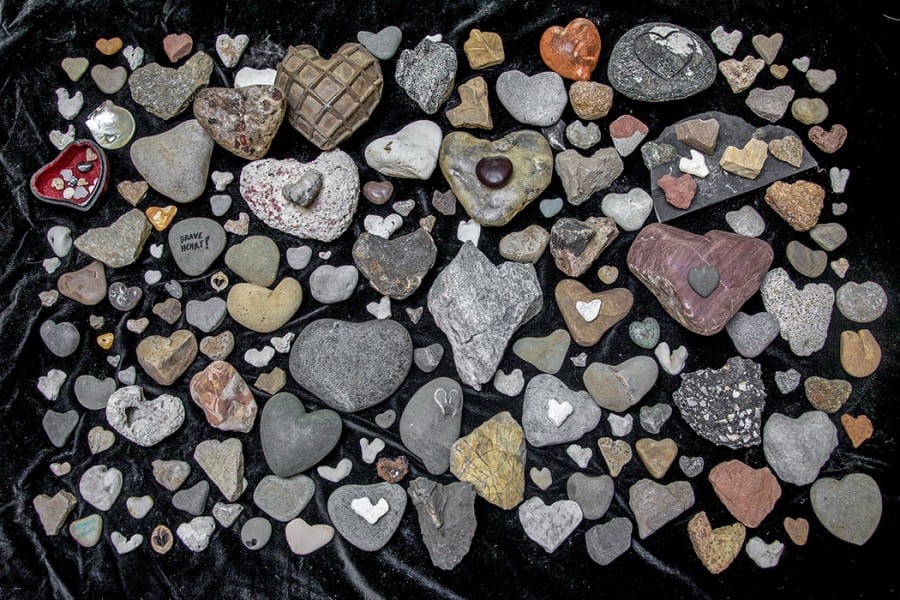
LB: Then Matt, came along and said you’ve got to go with me to a drag show sometime. So I went to a drag show. The second time I went to the drag show, only with my iPhone, I didn’t go intending to take pictures but he took me into the dressing room in the back and I saw this one woman and took a picture of her. I said this is what I want to do. So we’ve been going to one drag show after another and I have a huge body of drag show queens.
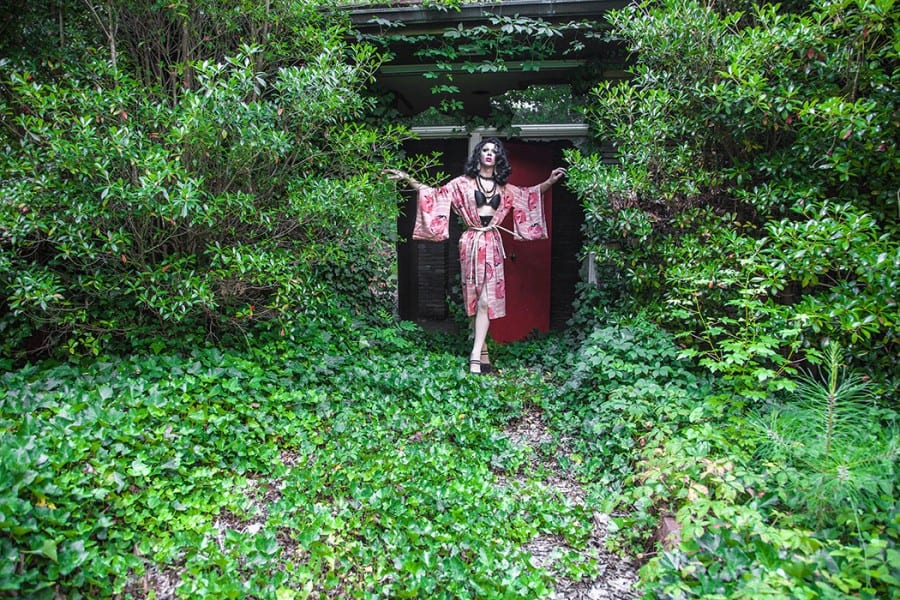
BG: It sounds like your vision was already ahead of your knowledge of the technology of shooting. LB: So that’s number three. And then, number four came out of the woodwork from going through the archive with Matt and finding the essentially ruined slides. I said “Why can’t we make this happen?” So we put them out on the porch and let the rain come down….and they have been making magic.BG: Most people who looked through their slides and found they’d been damaged by moisture would be devastated. But you saw that and saw that there was possibility. Is that a just your glass half full? LB: No, I was making this magic down in my darkroom, I was making sandwiches and my husband gave me another enlarger. So I had two enlargers so I was able to Jerry Uelsmann things…I took a course from Jerry Uelsmann and, that same weekend that he was here I found out how to do something that I’d been wanting to do. I’d also done a lot of work with infrared. So I put some things together and brought them back to the class the next day and he asked “Well, when did you do that?” and I said “Last night.” I’m always geared up to do something new and exciting.BG: But this new work, Weathered Chrome, is allowing something to come out of nothing…well, not nothing, you had the images to start, but something that would be someone else’s tragedy has turned into a triumph. It’s amazing. LB: It is amazing. So that’s my four bodies of work right now. If you look at my resume, I’ve had shows of China and Cuba, of trees, hundreds of shows.
BG: Even looking back when you were talking about shooting at the pond, the stalks coming out of the ice and the water, that’s about some level of decay…is that a thread?
LB: I’ve always liked decay and I’ve always picked up junk. One of my collections is detritus from Kauai. When I was walking on the streets of Kauai and on paths…I found all this stuff, I don’t even know what half of it is. And I’ve put it together and made some pictures of it. That is what started the photographing of collections…but I didn’t really think of it that way.
BG: When you see things and they call to you.
LB: I know I have a cow collection because I grew up on a farm and I milked cows before I went to school in the morning. I have a smaller horse collection because I was a horsewoman. The only thing that didn’t work for me was my ceramic collection. I couldn’t make that work in a photograph.
BG: Maybe it’s not complete yet.
LB: Something.
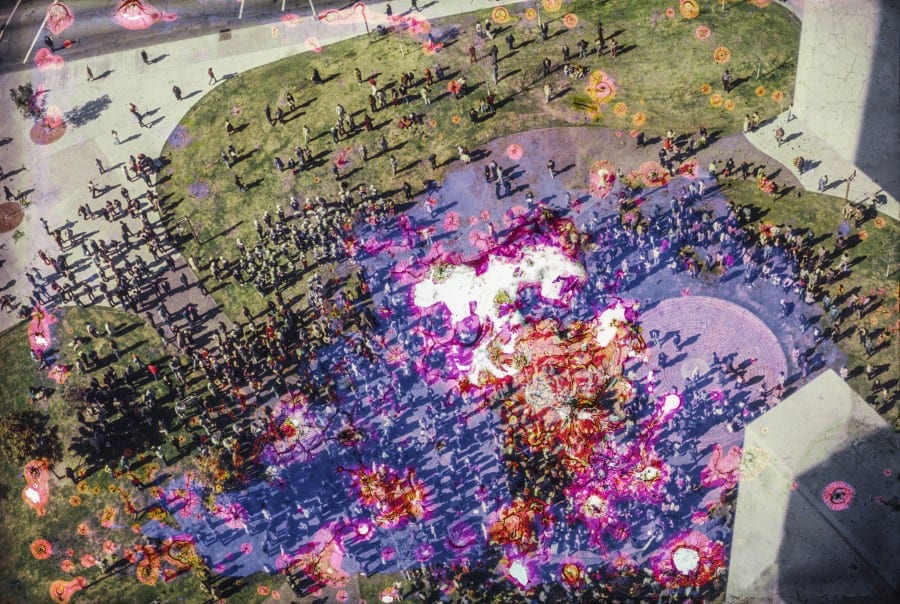
LB: Right! I have no idea how long they should stay there. Every time I go and look I find something that’s full of color or something. I’ve been putting them on parchment paper to dry. There is no right or wrong way, there is no key to success with this. It’s just exciting!
BG: Talk through your process with this work.
LB: I’m not sure how I selected the pictures because every once in a while I come to one and say “What is this doing here?”
M: Why don’t you start earlier than that…right at the beginning in the archive?
LB: The sorting out?
M: Start from the very beginning and explain the process of that.
LB: There were some slide shows and…I’m always thinking about what my kids are going to do with all this. I’m about to be 85 years old. And it’s about to be time to start thinking about where everything is going to go. I want everything to go where I want it to go. I want my books to go to MOCA GA, the High Museum, WonderRoot and Spelman College. Boxes and boxes and Matt has helped me do that. It’s always a process of what is anyone going to look at after I’m gone and what are they going to make of it after I’m gone. So we have to not have too much for anybody to have to deal with so let’s get rid of some of it. So what’s happened is that some of what we’re getting rid of is going to be seen in another dimension and maybe we can put more. But we’ll have to see who’s going to show it, what we’re going to do with it and how many we can print, how big to print them, how big to make the editions. We don’t want to flood the market with these but on the other hand it’s so exciting to every day go out and find another one.
M: Lucinda, how did you select which slides you wanted to put out into the rain?
LB: I don’t remember, I don’t. I just thought you don’t need all these. We put them in sleeves, in boxes all labeled and I keep saying to them we don’t need so many, let’s don’t keep so many.
M: After the 10,000th sleeve…
all laugh.
LB: Enough! He said “Should I order one hundred more sleeves?” and I said “No. No. No more.” We’re going to get rid of them. So that’s how it happened I think.
BG: That’s exciting because it’s organic…this whole process. You didn’t know what you didn’t know was going to be on there in a way. How long do you set the images outside, how random? How often do you check them?
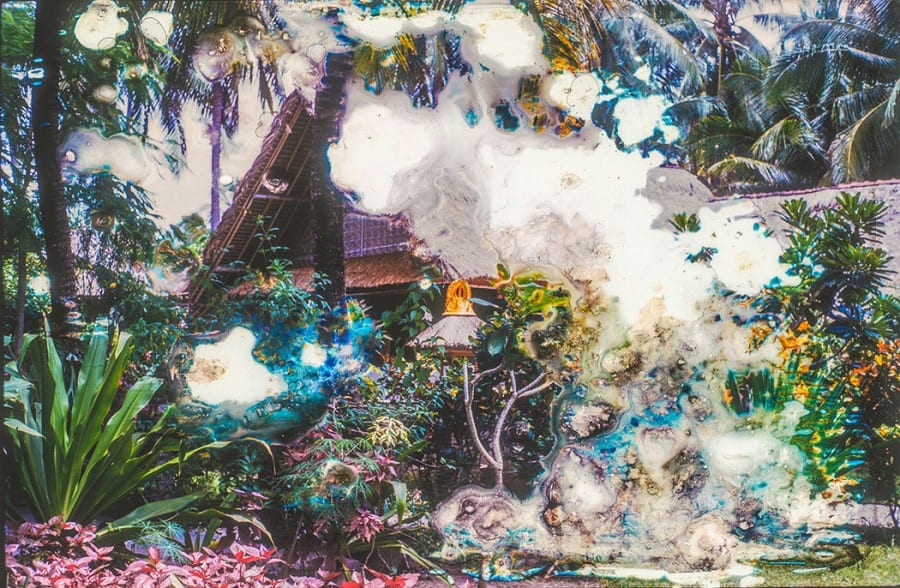
MT: What’s the weather going to be like?
LB: I think it’s going to rain all weekend. My housekeeper is going to house sit with the dogs.
MT: Just tell her to empty water out.
BG: You are amazing, Matt. I adore you already.
LB: He is amazing. I promise you none of this would have happened without him. Because I wouldn’t be going through my archive to start with and you have to have somebody to say “What do you think – should I? Shouldn’t I? What should I do with this?” He kept pushing the archive more, more, more. Nobody’s going to go through it, they’re going to throw it away. I’m thinking there will probably be an archivist of some kind that will come to my house after I’m gone and they need to have some way of knowing what’s here. My black-and-white negatives are very well marked, numbered with contact sheets. At the very beginning, the 35mm ones, I didn’t even make contact sheets. I would come in from a shoot, I would run down to the darkroom and I’d hang them up on a clothesline and look at them wet.I ruined a watch because of the water. It was a Tiffany watch and I took it back to Tiffany and they said it’s just full of water….
BG: And chemicals probably!
LB: And chemicals!
BG: Were you just so excited to see what you’d gotten?
LB: I started printing everything right away. You should wait, don’t do it right away. I look back at some of my contact sheets and think “Why didn’t I print that?” But of course, your taste changes, you get more mature, a little bit more sophisticated about it all.
BG: A little more willing to let go?
LB: Not have it be so perfect.
BG: How necessary was a willingness to give up control and let things organically happen, up to and including, deterioration of a chrome or chromes?
LB: When I was doing the heat process downstairs, a friend of my husband would come and play tennis a lot of noons. He would tell his secretary he was in court (laughs). They would play tennis and have lunch. I would come up from downstairs and say what I was doing. He would say, “You need to figure out what you’re doing and you should patent this because you’ve got something.” So then I took the meat thermometer down so I could tell exactly what temperature everything was and tried to figure it out. Then I would make several prints of one thing and do several different things…I was a little dis-organized…I couldn’t remember which one I did, which two…it was all hit or miss. And when they dried they would look different from when they were wet. So this is really sort of like that. Very exciting to see those when they were dry, I couldn’t wait to go downstairs and see what this heat process was all about. Then someone asked if they could borrow my dry mount press and that was the end of it. I had to get it cleaned. I got it back and I didn’t want to mess it up again.
BG: Because it was clean?
LB: Because it was clean (laughs).
BG: It sounds like you are constantly willing to try something new, explore…you are kind of fearless.
LB: I am fearless. I was a skier…when I was skiing in Europe they said I should be in the Olympics because I went faster than anybody and I didn’t even know how to ski!
BG: (laughing) That’s probably why. I’m glad you learned how to stop though!
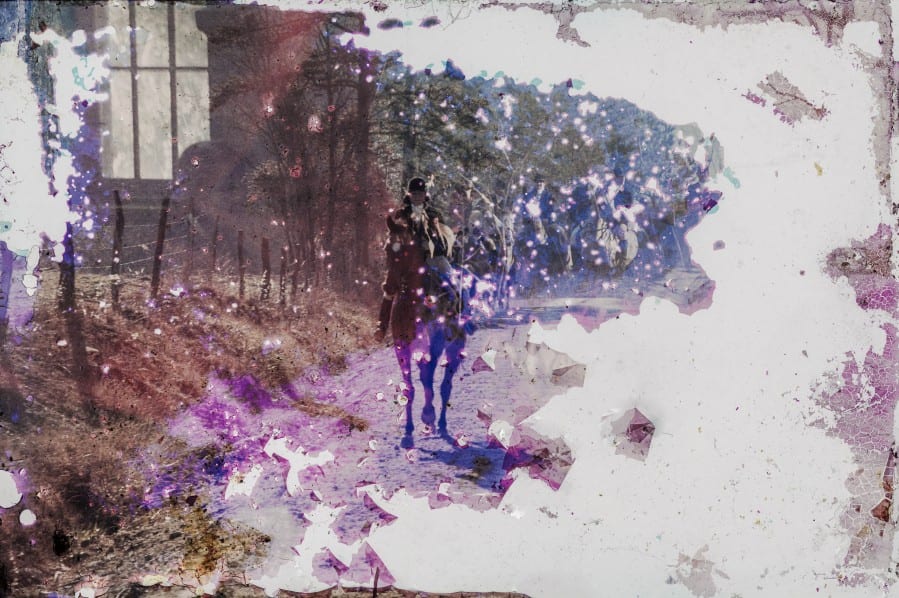
BG: (Laughs) That’s so great! Do you think starting in photography at 40 has anything to do with it? You didn’t learn rules you had to break from school in your 20’s.
LB: I know. When I went to Europe I had a camera and I put it down in the train and it was gone. I didn’t even care about the camera, it wasn’t that expensive. I cared about that roll of film because those were images that I had made…I wanted to see those images. I wanted to take them home to show them to my family because I wouldn’t be able to tell them what I saw. I wouldn’t be able to explain what I saw. That’s an interesting idea. You can say that you saw a flower or you saw a tree but you can’t talk about what you felt. I think that was what was on the film…what I felt that could not be explained or replaced. I couldn’t write home and say this is what I saw. I just felt like the pictures were going to be able to tell them what I saw. So long before I became a photographer, I was a photographer.
BG: As Brett Abbott says, the photograph is a powerful container of memories.
LB: My father had a Leica camera when I was a kid, which was the 30’s and 40’s. By the time he got it ready to shoot, the picture was gone.
BG: The moment was over?
LB: By the time he had aperture set…he couldn’t just put it on “P”…
BG: and go!
LB: He had to set it so I didn’t think photography was such a great thing.
BG: What are the characteristics, traits or drivers for continuous emergence?
LB: When I taught a little class I said “If you want to be a photographer, think of yourself as a professional photographer right away.” Not just a little Sunday painter. And then you can get good. But you have to want to do that.
BG: Is that just a confidence thing?
LB: It’s a confidence thing. I have to say that having made pictures that stood up in time gives you confidence. I had my first picture of the nuns scanned and printed big, put in an auction at MOCA GA a couple of years ago and it got to $2400. So they said would you do another one? So two for $2400 of my very first image!
BG: That image is as strong today as when you shot it.
LB: It is. People still want it.
BG: What advice would you give to photographers who are beginning to emerge, maybe for the first time, and find their place in the photography world?
LB: Let go of everything you’ve ever been told and do your own thing.
BG: That’s great advice, Lucinda! My next question was going to be what’s next for you?
LB: Heaven knows!
BG: But four bodies of work going at the same time is pretty impressive.
LB: I had 3 going and then the Weathered Chromes came out of the sky. Who knows!
BG: Just be open to the possibilities?
LB: I am open to the possibilities
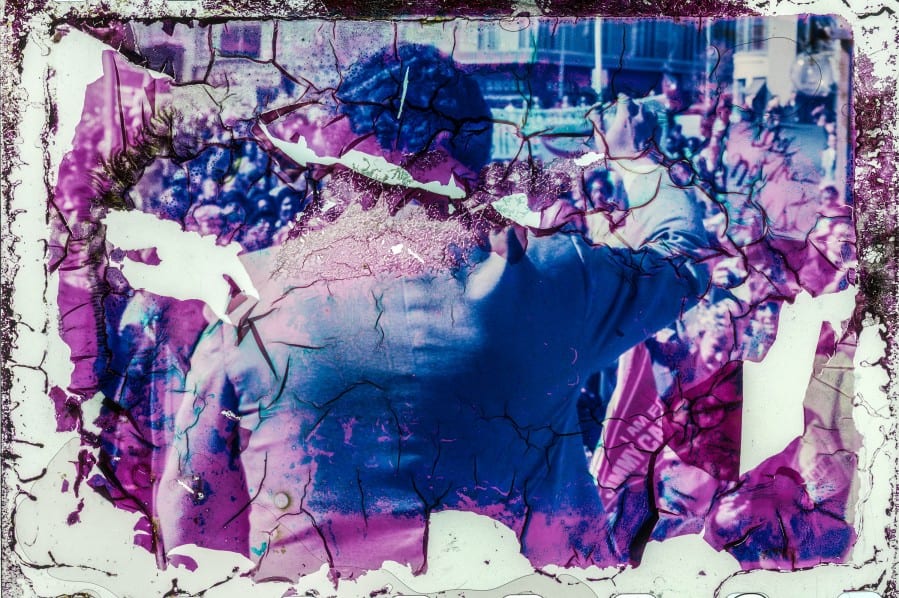
LB: It is a whole new thing because these were throwaways and now I can show them to my kids and say this is so and so, or this is when I was somewhere. They would never have seen them because they were going in the trash. Or the rest of them that I didn’t throw away from that same body of work…I don’t know if anyone will ever look at them. My projector doesn’t work. I’ve got a borrowed projector. Everything you used to use to show slides is gone. I still do have a screen. But my grandchildren are waaay beyond all that. I have grandchildren that should be having my great grandchildren…they haven’t yet. But that’s where I am in life. We didn’t have television growing up, we listened to Jack Benny on the radio and we didn’t have cell phones and now I can’t imagine how anyone got around without a cell phone.
BG: Or FedEx…world changing.
LB: Or digital cameras!
BG: Can you even imagine how they’ll be consuming images in 50 years?
LB: Well, everyone is a photographer. I have a big Canon camera. People ask me how I still carry it around. I say “Well, if you pick up a calf the day it’s born, and you pick it up every day, you can still pick it up when it’s a cow.
BG: You grow your muscle along with it.
LB: When I walk in the woods I have my iPhone. When I see something interesting to take a picture of I have my iPhone. It’s a 5S and it takes great pictures. I just went to my granddaughter’s first drama and I did a whole thing of her performance.
BG: Did she love it?
LB: No, she didn’t love it but I showed it to my other daughter who wasn’t there. I’ll take her to the beach and she’ll love it when she has time to look at it.
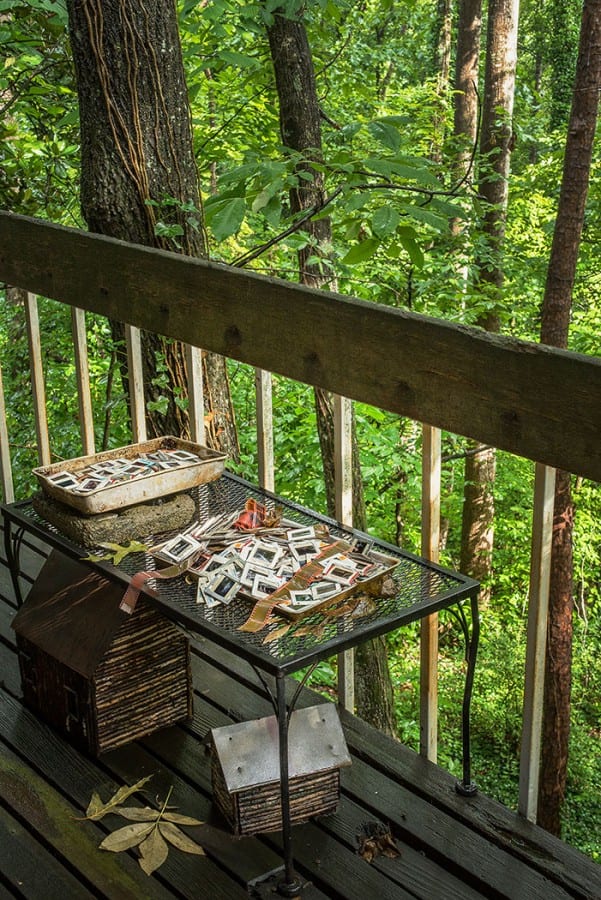
MT: Whoa…Nice!
(Background sound of more crackling.)
BG: You can stop on that one…that’s cooked!
LB: Let’s see.
BG: Is it wet? That’s amazing!
MT:Yeah!
LB: It is cooked! This has to go in.
BG: I love watching the process unfold.
MT: Of our lab…
BG: Of the lab!
BG: You know, working at a photo agency our biggest fear was that you would scratch or damage something a photographer sent you. It was sacred.
MT: I love that a lot of them evoke 20th Century Paintings…I see some Pollock’s and Rothko’s, Ellsworth Kelly’s in there.
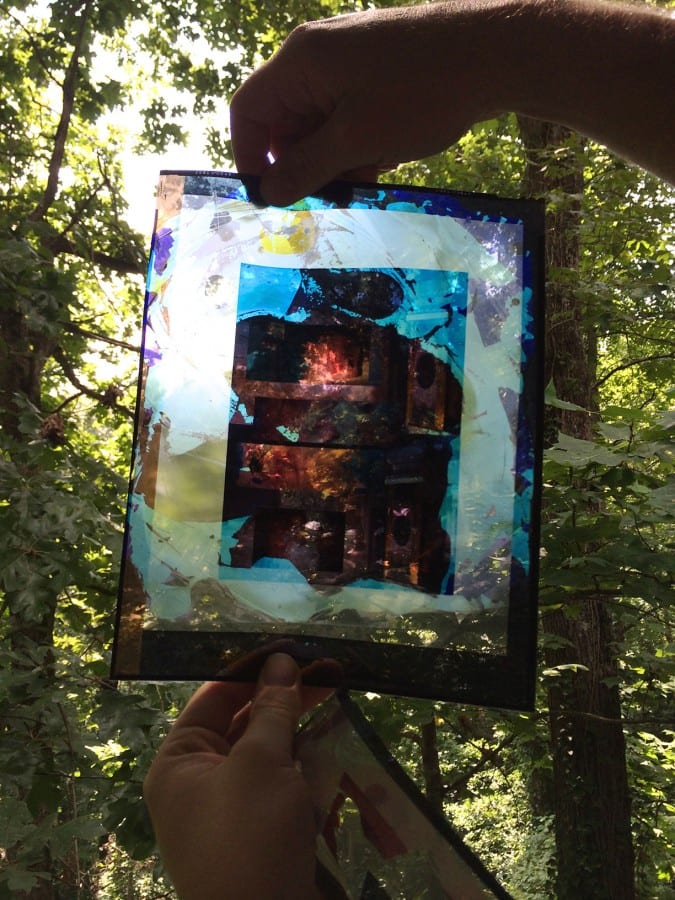
LB: Oh…wow
MT: Yeah, I think these are getting done.
LB: Wow
MT: It needs more time
BG: I love “it needs more time”
Phone ringing, LB goes to answer phone
BG: Matt, are you just in photo heaven?
MT: Every day.
Barbara Griffin
Barbara Griffin is an independent Creative Director, Producer and Photo Editor whose work ranges from photo shoot direction and production, exhibition curation to fine art photo book editing. In 2018, Barbara was named President Emerita after 8 years of leadership at Atlanta Celebrates Photography (ACP), a non-profit arts organization which produces the largest annual community-oriented photo festival in the U.S.
Barbara currently serves on the board of War Toys, a California based non-profit whose core mission is to advocate for children who have been affected by war. Unique, art-therapy-based collaborations with children amplify their voices and relay their often traumatic accounts to audiences around the world through exhibitions, presentations, and media engagement.
Barbara’s commitment to the photography and photographers is exemplified through her service on the advisory council of Space for Arts, the only studio listings site built specifically for the photography community and on the Advisory Council for ATL Photo Night, a creative organization that hosts monthly talks featuring photographers.
Additionally, she previously served on the board of re:imagine/ATL, a non-profit organization whose in-school and mobile programming serves Atlanta teens from all backgrounds by providing mentorship and resources in film and digital media.
Formerly, senior vice president of Image Management for Turner Broadcasting System, Inc., Barbara was responsible for all photography created globally for Turner's entertainment, animation and news networks.
Contact info:
Twitter: @barbaragriffin Instagram: @barbaragriffinrocks
LinkedIn: www.linkedin.com/in/barbaragriffin http://acpinfo.org/
https://wartoys.org/
https://www.spaceforarts.com/
https://www.atlphotonight.com/

